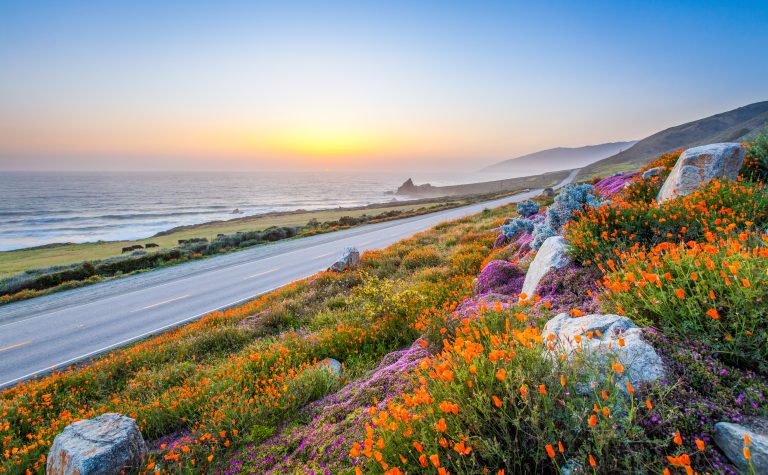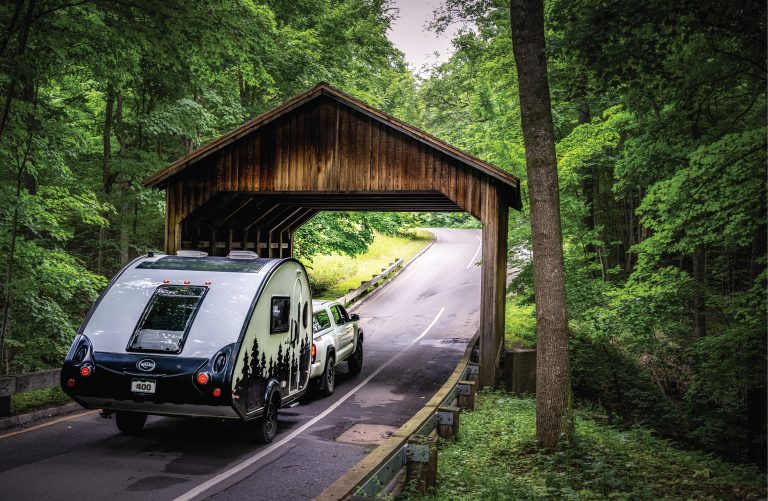Tennessee is located in the upper South of the eastern United States—an irregularly shaped rectangle stretching 432 miles east to west and only 112 miles from north to south. Bordered to the north by Kentucky and a small slice of Virginia, to the east by North Carolina, to the west by Missouri and Arkansas, and the south by Mississippi, Alabama, and Georgia, the state is divided vertically into three regions: East, Middle, and West. Those regions are depicted on the flag as three stars, bound together in indissoluble unity by an unending white band.
The East Region is known for Cherokee National Forest, the Appalachian Trail, and the Ocoee River—a challenge for whitewater enthusiasts. Travel through Middle Tennessee and you’ll enjoy true Southern hospitality and unforgettable music, courtesy of the state’s capital, Nashville, whose spirit permeates the region. As for the West Region, it’s a blend of urban can-do spirit and rural charm, iconic artists, and traditional cuisine. The Smokies get their own designation, well-deserved since it’s the home of the oldest mountains in the world with cascading rivers and majestic forests.
Tennessee joined the union in 1796 as the sixteenth state and covers 42,144 square miles, and has as its nicknames the Volunteer State, Big Bend State, and Hog and Hominy State. It’s also home to five of America’s Byways, four of which are shared with other states, as well as numerous trails and byways offering unique experiences for those who travel along them. (For a national map of America’s byways, go here.) Whichever region you explore and whatever path you take, your trip to Tennessee will be an unforgettable experience.
Note: Before heading to Tennessee, check this page and the Tennessee Pledge: Updated Business Guidance page for the latest coronavirus updates and regulations. Also, know what the health guidelines are in the various locales and bring along plenty of PPE (personal protective equipment) including masks.
East Tennessee Crossing
The East Tennessee Crossing Byway (also known as Highway 25E) is the only one of the five byways that begin and end within the state’s borders. Covering 83 miles, the scenic byway crosses the state diagonally, beginning at the North Carolina/Tennessee border and traveling northwest until it passes through the town of Cumberland Gap and ends at the Kentucky/Tennessee border.
Far from being just a way to travel through the state, the East Tennessee Crossing Byway is also a path to the past, since it follows the original path of the Cherokee Warriors Path, Wilderness Road across the Clinch Mountain and the Cumberland Gap, the Dixie Highway of the Civil War period, and Thunder Road of moonshining lore.
While traveling the East Tennessee Crossing Byway, allow time to visit Cumberland Gap National Historical Park, the Abraham Lincoln Memorial Museum, Cherokee National Forest and Martha Sunquist State Forest, and Great Smoky Mountains National Park.
The byway is also home to numerous opportunities to enjoy the musical and crafts heritage that are part of the area and the state itself, from bluegrass and gospel festivals to pottery, wine, agri-tourism, wood arts, and quilting. And for the outdoor adventurers, the Pigeon River is among the top in the nation for whitewater rafting, while other activities include hiking, fly fishing, powerboating, canoeing, horseback riding, cycling, and camping.
Cherohala Skyway
Cherohala Skyway is a relatively new addition to the byway list, since it was only opened and dedicated in 1996. The name itself comes from the names of the two National Forests: “Chero” from the Cherokee and “hala” from the Nantahala.
Forty-three miles in length, the skyway has elevations ranging from 900 feet above sea level at the Tellico River in Tennessee to more than 5,400 feet above sea level at the Tennessee-North Carolina state line at Haw Knob. A two-lane road with wide shoulders and 15 scenic overlooks, the skyway has some grades as steep as nine percent.
Cherohala Skyway calls both Tennessee and North Carolina home, changing from NC 143 to TN 165 when it crosses over into Tennessee. It offers visitors magnificent vistas including Great Smoky Mountains to the northeast and the Tennessee River Valley to the west, along with seldom-seen portions of the southern Appalachian National Forests. Other outdoor activities include hiking, kayaking, canoeing, camping, and bird watching
Be sure to stop at the Cherohala Skyway Visitor Center in Tellico Plains, open daily from 9:00 a.m. to 5:00 p.m., where you can find local and area information about lodging, attractions, and shopping as well as Skyway souvenirs and educational materials. When traveling the skyway, keep in mind the time of year, since the weather can vary depending on the season and the elevation.
Woodlands Trace
Woodlands Trace is another national scenic byway that runs through two states: in this case, Tennessee and Kentucky. The Tennessee portion of its 43-mile length begins at the intersection southwest of Grand Rivers, Kentucky and ends at the border of the Land Between the Lakes and the end of SR-461 near Dover, Tennessee.
Along the rolling terrain of the byway are developed interpretive facilities and plenty of natural areas to explore. Take your pick from camping, hiking, canoeing or kayaking, visiting Civil War sites or viewing the stars.
Natchez Trace Parkway
The 444-mile Natchez Trace Parkway travels from Nashville, Tennessee, briefly enters and then exits Alabama and terminates at the lower Mississippi section south of Jackson. The trail was a vital link between the Mississippi Territory and the fledgling United States, with Native Americans, Kaintuck boatmen, post riders, government officials, and soldiers moving along its path.
Drive along the Tennessee portion of the parkway and view forest and cypress swamps, farmlands and rock-studded hills. The entire parkway is a two-lane, undivided linear drive, popular for cyclists and drivers alike, with more than a dozen campgrounds and plenty of outdoor activities. Be sure to check out sites such as the Meriwether Lewis Park and Monument, the Devil’s Backbone State Natural Area, and Birdsong Hollow.
Great River Road
Great River Road covers 2,069 miles and runs through 10 states, starting north in Minnesota and crossing through Wisconsin, Illinois, Iowa, Missouri, Kentucky, Tennessee, Arkansas, and Mississippi until it terminates at the southeast end of Louisiana. The Mississippi River was integral to so many lives and cultures, from the Dakota, Chippewa, and Hopewell to early French voyagers to those African-American slaves who sought freedom and a new life via the Underground Railroad. Now, the Great River Road continues that vital role, linking resources and people.
The 185.5-mile Tennessee Corridor of the Great River Road is on the east side of the Mississippi River and goes from the Tennessee/Kentucky state line, and ends at the Tennessee/Mississippi state line. While traveling the Tennessee portion, you can visit Fort Pillow State Historical Park and Reelfoot Lake State Park, among other sites.
Recent Articles





